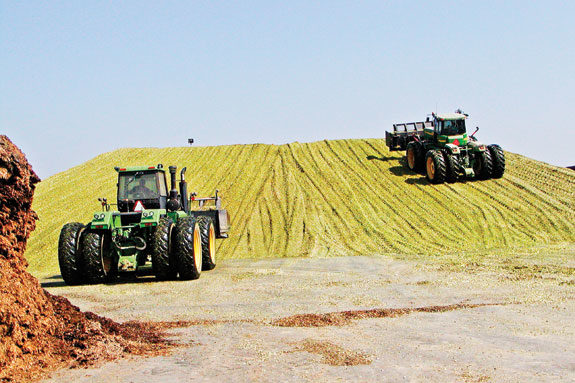I practice recycling – this includes cans and bottles, but also the information I’ve had to develop for farmer meetings.
Recently I presented a talk with the above title to some Virginia dairy farmers. Following are the high points:
1. Hybrid selection – The key to high-quality corn silage: A good ear on every plant. The key to high yield: Lots of plants – and therefore lots of ears – per acre.
Stover quality of conventional (dual-purpose) hybrids has changed little in 100 years, so the key to quality is the grain:stover ratio.
The exception is BMR corn hybrids, which have consistently higher fiber digestibility. BMR has some yield drag and isn’t for every farm, perhaps not even for most farms, but it puts milk in the tank.
2. Genetically modified (GM) traits – More GM traits mean more opportunities, but also more opportunity for confusion. Don’t spend money for traits you don’t need or won’t use – and pay attention to unintended impacts.
For instance, Bt-corn borer hybrids often remain healthy later into the growing season and therefore may be several points lower in percentage dry matter at silage harvest time. And why buy a glyphosate-resistant hybrid if you know you won’t be using glyphosate?
3. Plant population – Much of the yield increase in corn has been due to increases in plant population, particularly the ability to put on a good ear at a high population.
In most cases plant about 35,000 kernels per acre; you shouldn’t lose more than 10 percent to insects, disease, non-germinating seed, etc. and in some cases as little as 5 percent. Shoot high; it’s better to have a thousand more plants than planned than a thousand less.
4. Fertilization – Base fertilization on soil analyses and responsible recommendations. (Where have you heard this before?) Don’t overlook micronutrients, particularly where you don’t apply manure.
Manure is a multivitamin. Soil analysis is fairly reliable for zinc and boron, but tissue analysis is better for most other micronutrients. Zinc is the most commonly deficient micronutrient in corn, and supplementation isn’t expensive.
5. Pest control – Seed treatment is now “in the bag,” so to speak, since most seed corn now comes treated with an insecticide-fungicide combination.
The low (250) rate controls seed corn maggots and seedling diseases, while the highest rate (1250) provides some rootworm control. The Bt-rootworm trait works great where needed, but there’s still a place for soil insecticides, and particularly for crop rotation.
6. Maturity – This is still one of the biggest shortcomings in many corn silage programs. 30 percent DM is not ideal; 33-35 percent will result in higher dry matter yields and considerably higher silage quality. If you process your corn, aim for 34-35 percent DM – even if you miss by 2 percent high or low you’ll still be OK.
7. Evaluation of chopper effectiveness – Put a quart of fresh-chopped corn or corn silage in a pail of water and stir for a few seconds. Remove all the floating material and pour out the water. What remains in the bottom of the pail is almost entirely kernels.
Processed corn should have no more than 5 percent unbroken kernels. For nonprocessed corn, 25 percent whole kernels is as good as it usually gets. That’s why processors are so popular!
8. Proper packing – Whether bunker or stack: Pack, pack, pack. With the rapid rate of silo filling on many farms, you’ll need two or more packing tractors. (Miner Institute has used three tractors on its drive-over piles.)
Delivery rates exceeding 100 tons per hour can make proper packing difficult, especially bunkers where packing with more than two tractors is impractical. The “push tractor” (the one with the blade) needs to spread no more than a six-inch layer of forage over the silage surface.
9. Delay feeding new-crop corn silage – Corn silage is not a stable feedstuff: Over time it increases in both starch and protein degradability, with the changes in starch most important.
The corn silage you’re feeding now and into the summer is almost certainly higher in starch digestibility than any “new crop” corn silage you may have been feeding in November, enough higher that it probably would mean a change in rations. If possible, delay feeding new-crop corn silage until the following calendar year.
10. Test, test, test – Whether it’s the dry matter content of the corn you’re about to chop, the corn silage you fed this morning or the fields you’ll be planting in two months, you need to know what you’re dealing with so that you can plan and act accordingly. Good farmers make things happen, while poor ones wonder what happened. FG
—Excerpts from Miner Institute Farm Report, March 2012
PHOTO
Whether bunker or stack: Pack, pack, pack. With the rapid rate of silo filling on many farms, you’ll need two or more packing tractors. Photo by FG staff.













